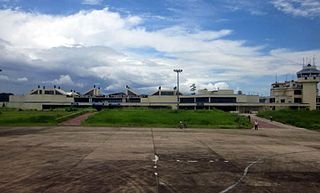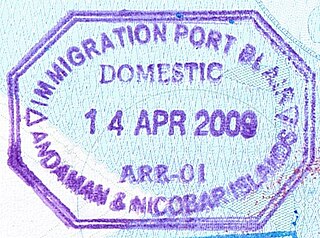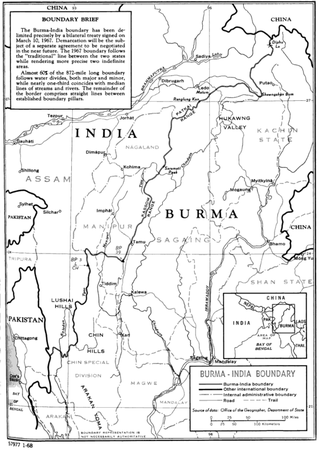
Arunachal Pradesh is a state in northeast India. It was formed from the North-East Frontier Agency (NEFA) region, and India declared it as a state on 20 February 1987. Itanagar is its capital and largest town. It borders the Indian states of Assam and Nagaland to the south. It shares international borders with Bhutan in the west, Myanmar in the east, and a disputed 1,129 km border with China's Tibet Autonomous Region in the north at the McMahon Line. Arunachal Pradesh is claimed by China as part of the Tibet Autonomous Region; China occupied some regions of Arunachal Pradesh in 1962 but later withdrew its forces.

Nagaland is a landlocked state in the north-eastern region of India. It is bordered by the Indian states of Arunachal Pradesh to the north, Assam to the west, Manipur to the south, and the Naga Self-Administered Zone of the Sagaing Region of Myanmar (Burma) to the east. Its capital city is Kohima and its largest city is the twin Chümoukedima–Dimapur. The state has an area of 16,579 square kilometres (6,401 sq mi) with a population of 1,980,602 as per the 2011 Census of India, making it one of the smallest states of India.

Kohima is the capital of the Indian state of Nagaland. With a resident population of almost 100,000, it is the second largest city in the state. Kohima constitutes both a district and a municipality. The municipality covers 20 km2 (7.7 sq mi). The city lies on the foothills of Japfü section of the Barail Range located south of the District and has an average elevation of 1,261 m (4,137 ft).

The Insurgency in Northeast India involves multiple separatist militant groups operating in some of India's northeastern states, which are connected to the rest of India by the Siliguri Corridor, a strip of land as narrow as 14.29 miles (23.00 km) wide.

Dimapur is the largest city and municipality in the Indian state of Nagaland. As of 2011, the municipality had a population of 122,834. The city is the main gateway and commercial centre of Nagaland. Located near the border with Assam along the banks of the Dhansiri River. Its main railway station is the second busiest station in Northeast India. The District of Dimapur is bifurcated into two other districts; namely, Chumoukedima and Niuland.

Kohima District is a district of the Indian state of Nagaland. It is the home of the Angami Nagas. As of 2011, it is the most populous district of Nagaland, with a population of 267,988, 45% of which is urban. The district is home to 13.55% of Nagaland's entire population. The administrative headquarters of the district is located at Kohima, the capital city of Nagaland. Kohima District is also the seventh-largest district in Nagaland with an area of 1,207 square kilometres (466 sq mi).

Dimapur Airport is a domestic airport serving Chümoukedima–Dimapur and its neighbouring areas. It is located between the districts of Chümoukedima and Dimapur, from where National Highway 29 passes just beside the airport. It is the only airport in the state of Nagaland. The terminal building can handle 500 departing and 300 arriving passengers, and was built during World War II. There are plans for expansion of the airport to meet international norms by acquiring land at Aoyimti Village.

The Foreigners Order, 1958 states that a Protected Area Permit (PAP) is required for non-Indian citizens to visit certain areas in India. Certain requirements have to be fulfilled in order to get this permit. Indian citizens who are not residents in these areas need an Inner Line Permit (ILP) to enter these places. The Inner Line Permit is significantly easier to get.

Inner Line Permit (ILP) is an official travel document issued by the state government concerned to allow inward travel of an Indian citizen into a protected area for a limited period. It is obligatory for Indian citizens from outside those states to obtain a permit to enter the protected state. The document is an effort by the government to regulate movement to certain areas located near the international border of India. An ILP is usually significantly easier to obtain than the analogous Protected Area Permit (PAP) which is the document required by non-citizens to enter the same areas.

Overseas Citizenship of India (OCI) is a form of permanent residency available to people of Indian origin and their spouses which allows them to live and work in India indefinitely. It allows the cardholders a lifetime entry to the country along with benefits such as being able to own land and make other investments in the country.

The Hornbill Festival is an annual festival celebrated from 1 to 10 of December in the Northeastern Indian state of Nagaland. The festival represents all ethnic groups of Nagaland for which it is also called the Festival of Festivals.

Dimapur Railway Station is a railway station on the Lumding–Dibrugarh section. It is located in Dimapur District in the Indian state of Nagaland. It serves Dimapur and its surrounding areas.
The 2015 Dimapur mob lynching was a case of mob lynching that took place in Dimapur, Nagaland, India, on 5 March 2015. A mob of about 7000–8000 people broke into a prison, dragged a man detained under accused of rape out of the Dimapur Central Jail, paraded him naked and beat him to death in a case of vigilante justice.

The following outline is provided as an overview of and topical guide to Nagaland:
Padma Shri Piyong Temjen Jamir was a noted Hindi scholar and littérateur from Longsa village under Mokokchung district in Nagaland state of India. He was conferred the Padma Sri honour by the President of India, Ram Nath Kovind, in 2018 for the promotion of Hindi language and social work.
The Citizenship (Amendment) Act, 2019 (CAA) was passed by the Parliament of India on 11 December 2019. It amended the Citizenship Act, 1955 by providing an accelerated pathway to Indian citizenship for persecuted religious minorities from Afghanistan, Bangladesh and Pakistan who arrived in India by 2014. The eligible minorities were stated as Hindus, Sikhs, Buddhists, Jains, Parsis or Christians. The law does not grant such eligibility to Muslims from these countries. The act was the first time that religion had been overtly used as a criterion for citizenship under Indian law, and it attracted global criticism.
The Dhansiri–Zubza Line is a single-track railroad under construction between the two major cities of the Indian state of Nagaland—Dimapur and Kohima. The line starts from Dhansiri junction near Dimapur Railway Station to Kohima Zubza Railway Station. It is a part of Northeast Frontier Railway zone of Indian Railways.

The India–Myanmar border is the international border between India and Myanmar. The border is 1,643 kilometres (1,021 mi) in length and runs from the tripoint with China in the north to the tripoint with Bangladesh in the south.

Chümoukedima District is the 15th district of the Indian state of Nagaland. It was created on 18 December 2021. The district is bounded by Kohima District to the east, Peren District to the south, Tseminyü District & Niuland District to the north-east, Dimapur District to the north and Karbi Anglong District of Assam to the west and north-west. The district headquarter is located in the municipality of Chümoukedima.














